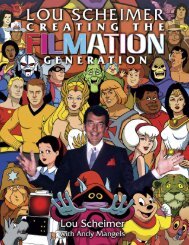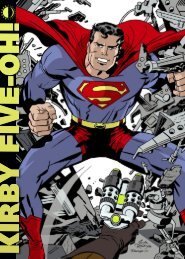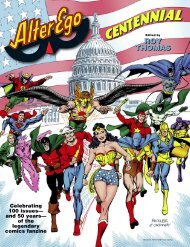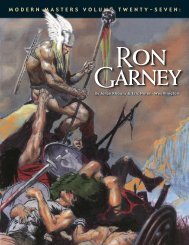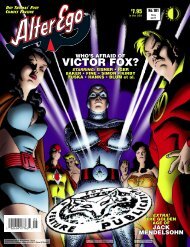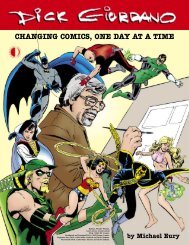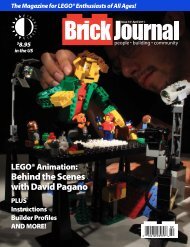Original Comic Book Art And The Collectors - TwoMorrows
Original Comic Book Art And The Collectors - TwoMorrows
Original Comic Book Art And The Collectors - TwoMorrows
You also want an ePaper? Increase the reach of your titles
YUMPU automatically turns print PDFs into web optimized ePapers that Google loves.
COPY AREA<br />
ABOVE: Saga of the<br />
Swamp Thing #21,<br />
(Feb. 1984), pg. 21,<br />
pencils: Steve Bissette,<br />
inks: John<br />
Totleben.<br />
OPPOSITE: Batman<br />
#608 (Dec. 2002),<br />
cover, pencils: Jim<br />
Lee, inks: Scott<br />
Williams.<br />
Characters TM & ©2009 DC<br />
<strong>Comic</strong>s.<br />
SPARTA<br />
pg. # 10 <strong>Book</strong> GRAILPAGES: <strong>Original</strong> <strong>Comic</strong> <strong>Book</strong> <strong>Art</strong> and the <strong>Collectors</strong><br />
GRAILPAGES<br />
esteem of a true collectible. <strong>Original</strong> comic art had at one point<br />
been traded for old comic books. Old comic books still remain<br />
a viable collectible, especially when copies of Captain America<br />
#1 sell for as much as $8,950. But somewhere down the<br />
line someone made the quantum realization that buying a comic<br />
book gave you one out of 100,000, but original art on the other<br />
hand was one of a kind.<br />
Commercial art, production art, copy art — it has been given<br />
many names, most intended to be polite euphemisms for something<br />
detractors feel can be easily dismissed. Just as there are<br />
those who do not believe dinosaurs were actually living creatures,<br />
who don’t believe that man ever set foot on the moon, the<br />
whole act staged in the Mojave desert, there are those who do<br />
not believe comic book art collecting is a worthwhile hobby.<br />
Once art is done for hire, for many it is no longer art. To these<br />
critics, art is something done not for monetary or statuary gains,<br />
but emerges from an uncontrollable urge to create, much like<br />
some mad god’s dream.<br />
But by that definition many held in the embracing arms of art’s<br />
warm esteem will have to be let loose. People like Norman Rockwell,<br />
whose bucolic, visual anecdotes were done for the publication<br />
Saturday Evening Post, N.C. Wyeth and the inhabitants of his<br />
color-soaked cherubic realms, or the diminutive Henri Toulouse-<br />
Lautrec, whose garishly colored, wildly kinetic fever dreams were<br />
done as promotion for the Moulin Rouge. Either these talents and<br />
many others will forever be barred from the realm of art, or the definition<br />
has to be broadened and ameliorated.<br />
Given the high dollar value of ’60s and ’70s comic book art,<br />
it comes as no surprise that claiming a greedily large wedge of<br />
the pie chart demographics of collectors are professionals like<br />
Dr. Hari Naidu, marking a loftier assemblage for what is thought<br />
of as a cloistered, idiosyncratic market. If it really is a cloistered,<br />
idiosyncratic market.<br />
“Compared to the market for say automobiles, yes,” Ed<br />
Jaster, ex-Chicagoan and Director of Acquisitions at Heritage<br />
<strong>Comic</strong>s clarified. “But as a collectible, (comic book art) collecting<br />
is a significant hobby.” His claim is backed up by his<br />
company’s tallies. In business since the 1960s, Heritage<br />
Galleries and Auctioneers began auctioning comic book<br />
artwork on their website, www.heritagecomics.com, and at live<br />
auctions at conventions in 2001. Based out of Dallas Texas,<br />
they are the third largest auctioneer in America with sales<br />
exceeding $350 million annually. 30% of Heritage’s Pop<br />
Culture revenue is from comic art sales, about $8 million dollars.<br />
Ed has sold a John Romita Spider-Man cover for $75,000,<br />
and his personal best, a 1939 Superman cover that sold for<br />
$135,000, both rivaling the costs of the minor works of recognized<br />
artists like Sickert or Remington or even Picasso. During<br />
the summer of 2002, Heritage grossed $5 million at their<br />
signature auction held in Chicago. Included amongst Heritage’s<br />
sales was a John Romita cover for Amazing Spider-<br />
Man #69 that fetched $41,400.<br />
<strong>The</strong> buyer of that piece was Bill Woo, a 46-year-old comic<br />
book shop owner from Delaware. Though not the most expensive<br />
page he’s ever bought, that honor going to the cover for<br />
Fantastic Four #55, his collection has made Bill, along with<br />
others like Dr. Hari Naidu, rock stars in the field of comic art<br />
collecting. <strong>The</strong> Heritage buy was a novelty for Bill, whose 30<br />
prized pieces, like much of Naidu’s prodigious collection, were<br />
largely culled from a less public forum.<br />
COPY AREA



